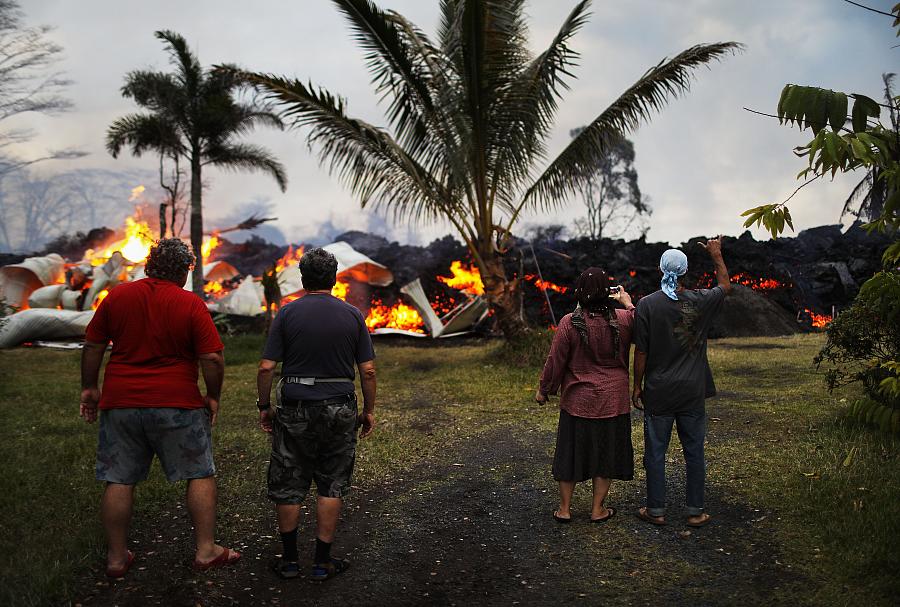Hawaii’s spewing volcano is a massive health crisis for island's most vulnerable

Community members watch as a home is destroyed by lava from a Kilauea volcano fissure in Leilani Estates, on Hawaii's Big Island, on May 25. (Photo by Mario Tama/Getty Images)
Malia Portia, a 66-year-old Hawaii Island resident, recently evacuated her home in Puna as billows of thick smoke and lava from the Kilauea volcano continue to threaten thousands of residents in the rural community.
“I left because of the smoke and the future ... bad air quality,” said Portia, who suffers from asthma and COPD, or chronic obstructive pulmonary disease, which restricts airflow from the lungs. “Four years ago (when the volcano was erupting), I was coughing up green, red and yellow. It was terrible.”
As Kilauea started spewing lava and ash in early May, it also unleashed a wave of serious health effects for some of the state’s poorest and most vulnerable residents. The disaster has been made worse by a shortage of doctors and a disproportionate number of residents like Portia already suffering from chronic illnesses.
There were 15,600 Puna adults with respiratory conditions, including COPD and asthma, according to 2016 state health statistics. That’s largely due to higher rates of smoking, the Hawaii Health Department said. An estimated 22.4 percent in the area currently smoke, compared to 13 percent of residents statewide.
The prevalence of COPD is also higher among adults 45 and older, with 10 percent of Puna residents living with the condition, compared to about 6 percent across the islands. About 20 percent of Puna adults and a quarter of children have been diagnosed with asthma, compared to 17.5 percent and 16.8 percent, respectively, statewide.
“There’s a lot of folks living in that region with pre-existing respiratory conditions that place them at increased risk for the effects of vog,” said Ranjani Starr, an epidemiologist at the Health Department, using a term that refers to volcanic smog.
The health effects of the toxic fumes that include sulfur dioxide were readily apparent while reporting on the scene in late May. The fumes caused me to have severe migraines and stomachaches immediately after breathing the air near the site of active fissures in Leilani Estates. The County of Hawaii has issued mandatory evacuations in lower Puna and is urging residents to get out or risk being isolated by the unpredictable eruptions. Thousands have evacuated their homes to escape toxic gases and fast-moving lava that has destroyed or isolated more than 100 structures so far.
As Kilauea started spewing lava and ash in early May, it also unleashed a wave of serious health effects for some of the state’s poorest and most vulnerable residents.
The elderly, children and those with respiratory illnesses who are exposed to high levels of sulfur dioxide in areas of volcanic activity are twice as likely to develop acute respiratory disease, warns state Sen. Josh Green (D, Kona-Kau), an emergency doctor on the Big Island.
Puna residents are especially vulnerable to the latest emergency because of stark health and socioeconomic disparities. The region has the second-highest poverty rate in Hawaii — nearly half of its residents live at or below 130 percent of the federal poverty level.
“There's extreme economic disparities, and in turn there's health disparities also,” Green said. “There's a much larger number of people who are of Hawaiian ethnicity so that's a challenge. We also know that the Hawaiian community has a lifespan of eight years less than the average. There's an ethnic health disparity then there's the economic disparities. That’s why we’re going to need to provide a lot of extra support just to keep them alive.”
Native Hawaiians account for an estimated 32 percent, or 14,500, of Puna's populutation, compared to 21 percent statewide, according to the nonprofit native Hawaiian health system, Papa Ola Lokahi.
Pacific Islanders, including Native Hawaiians, have historically had higher rates of chronic disease, resulting in greater mortality. A majority live in poverty with low education and limited access to nutritious foods, higher rates of tobacco use, greater obesity prevalence and unhealthy lifestyles.
“Hawaiians are overrepresented in the Puna population that's most impacted by the current lava flows,” said Kim Birnie, Papa Ola Lokahi spokeswoman. “We’re looking at disparities under normal circumstances and now the volcano is presenting additional challenges.”
Kristen Consillio is a staff writer for the Honolulu Star-Advertiser. She can be reached at hawaiibizreporter@gmail.com

